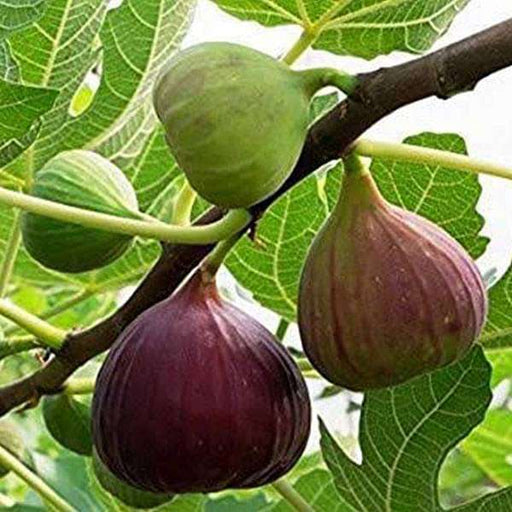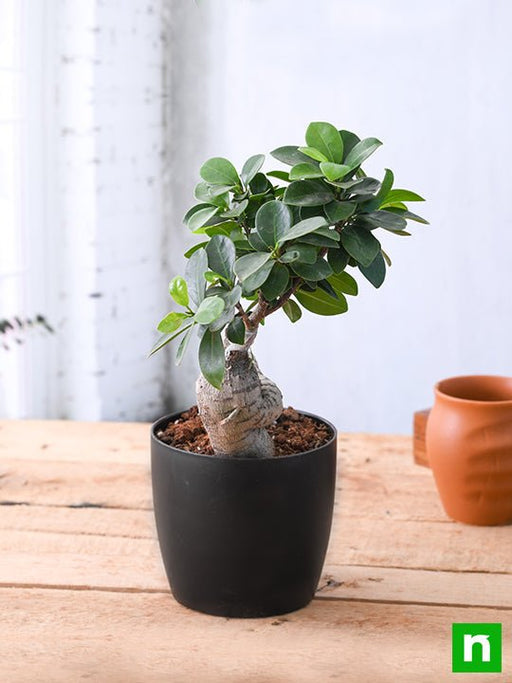
Ficus Bonsai Vertical Braided Arrangement - Plant
(MRP Inclusive of all taxes)
- Shipping ₹79 for entire order
- Dispatch in 7 days
- Country of origin: India

(MRP Inclusive of all taxes)

 Save 19%
Save 19%
Ficus Lyrata Bambino, Dwarf Fiddle Leaf Fig - Plant The Ficus Lyrata Bambino, commonly known as the Dwarf Fiddle Leaf Fig, is a stunning h...
View full details
 Save 26%
Save 26%
Creeping Fig Plant, Ficus pumila The Creeping Fig, scientifically known as Ficus pumila, is a versatile and resilient climbing plant nativ...
View full details Save 17%
Save 17%
Fig Tree, Anjeer Fruit, Common Fig Fruit - Plant The Fig Tree, scientifically known as *Ficus carica*, is a deciduous tree that produces t...
View full details
 Save up to 29%
Save up to 29%
Rubber Tree, Rubber Plant, Ficus elastica (Small) - Plant The Rubber Tree, scientifically known as Ficus elastica, is a stunning indoor plant that...
View full details
 Save 16%
Save 16%
Ficus Bonsai - Plant The Ficus Bonsai is a captivating miniature tree that brings a touch of nature's elegance into your home or office. K...
View full details
 Save 17%
Save 17%
Rubber Tree, Rubber Plant, Ficus elastica The Rubber Tree, scientifically known as Ficus elastica, is a stunning indoor plant renowned for...
View full details
 Save 23%
Save 23%
Rubber Tree, Rubber Plant, Ficus elastica (Black Prince, Burgundy) The Rubber Tree, scientifically known as Ficus elastica, is a stunning ...
View full details Save 15%
Save 15%
Pack of Vermicompost and Neem Cake for House Plants Transform your indoor garden with our premium Pack of Vermicompost and Neem Cake, spec...
View full details
Pack of Plant Growth and Flower Boosters Unlock the full potential of your garden with our Pack of Plant Growth and Flower Boosters! This ...
View full details Save 38%
Save 38%
Combo of Jeevamrut and Neem Raksha for Easy Growth and Protection of Houseplants Transform your indoor garden with our exclusive combo of ...
View full details Save 22%
Save 22%
Plant Nutrients Kit (Pack of 16) for a Healthy Garden Transform your garden into a lush paradise with our Plant Nutrients Kit, featuring 1...
View full details Save 16%
Save 16%
Combo of Top Plant Fertilizers Elevate your gardening game with our exclusive Combo of Top Plant Fertilizers, featuring two bags of premiu...
View full details Save 24%
Save 24%
Pack of 4 Additives to Make Soil Healthy and Nutrient Rich Transform your garden into a thriving ecosystem with our Pack of 4 Additives de...
View full details Save 30%
Save 30%
Transform your gardening experience with our premium Combo of Perlite and Vermiculite. This unique blend is designed to enhance soil aeration and ...
View full details Save 27%
Save 27%
Combo of 2 Vermicompost and Cocopeat - Enrich Your Soil Naturally! Transform your garden into a thriving ecosystem with our Combo of 2 Ver...
View full details
 Save 35%
Save 35%
Best 6 Plants for Perfect Indoor Garden Transform your living space into a lush oasis with our curated collection of the Best 6 Plants for a...
View full details
 Save up to 50%
Save up to 50%
Mini Succulent Garden Pack Transform your space with our Mini Succulent Garden Pack, featuring a delightful collection of 4 any variety beautiful s...
View full details
 Save 30%
Save 30%
5 Best Fragrant Plants Transform your garden or indoor space into a fragrant paradise with our curated selection of the 5 Best Fragrant Plants. Th...
View full details
 Save 24%
Save 24%
Set of 2 Bonsai Looking Grafted Adeniums Transform your indoor or outdoor space with our exquisite Set of 2 Bonsai Looking Grafted Adenium...
View full details Save 45%
Save 45%
Top 4 Die Hard Succulents Pack Transform your indoor or outdoor space with our Top 4 Die Hard Succulents Pack, featuring a curated selecti...
View full details
 Save 30%
Save 30%
5 Best Indoor Plants Pack Transform your living space into a lush oasis with our '5 Best Indoor Plants Pack.' This carefully curated collection fe...
View full details
 Save 25%
Save 25%
Set of 4 Evergreen Air Purifier Plant Pack Transform your indoor space into a lush, green oasis with our Set of 4 Evergreen Air Purifier Pla...
View full details| SrNo | Item Name |
|---|---|
| 1 | Ficus Bonsai Vertical Braided Arrangement - Plant |
The Ficus Bonsai Vertical Braided Arrangement is a stunning indoor plant that brings a touch of nature into your home or office. Known for its elegant braided trunk and lush green foliage, this bonsai is not just a plant; it's a living piece of art. The Ficus species, particularly Ficus retusa, is celebrated for its resilience and adaptability, making it an ideal choice for both novice and experienced plant enthusiasts.
What makes this Ficus Bonsai special is its unique vertical braided design, which symbolizes strength and harmony. This arrangement not only enhances the aesthetic appeal of any space but also promotes a sense of tranquility and balance. The Ficus Bonsai has been cherished in Asian cultures for centuries, often associated with good fortune and prosperity.
Special features of this plant include its air-purifying qualities, which help improve indoor air quality by filtering toxins. Additionally, the Ficus Bonsai is low-maintenance, making it perfect for busy lifestyles. Its ability to thrive in various lighting conditions adds to its charm, allowing it to adapt to different environments.
By incorporating a Ficus Bonsai into your space, you contribute to a healthier environment. These plants absorb carbon dioxide and release oxygen, improving air quality. Additionally, they can help reduce stress and enhance overall well-being, making them a perfect addition to any eco-conscious lifestyle.
Caring for your Ficus Bonsai is like nurturing a tiny green diva. It demands just the right amount of sunlight, water, and love. Too much water? You’ll drown your little star. Too little? It’ll throw a tantrum and drop leaves like confetti. Keep an eye on humidity levels, and don’t forget to talk to it—plants love a good gossip session.
The world of bonsai is a fashion runway for trees. From the elegant upright style to the whimsical cascading look, each style tells a story. The vertical braided arrangement is like the tree’s version of a chic updo, showcasing its unique personality. Choose a style that resonates with your inner zen master or your quirky neighbor.
Ficus Bonsai isn’t just a plant; it’s a statement piece. Placing one in your living room instantly elevates your decor game. It’s like adding a splash of sophistication without the hefty price tag. Plus, it’s a great conversation starter—everyone will want to know your secret to keeping it alive.
Maintaining a Ficus Bonsai is akin to being a tree therapist. Regular pruning, repotting, and wiring are essential to keep it looking fabulous. Think of it as a spa day for your plant—trim those unruly branches and give it a fresh pot to strut its stuff.
The Ficus family is like a tree-hugging clan with a variety of personalities. From the classic Ficus retusa to the trendy Ficus microcarpa, each variety brings its own flair. Choosing the right one is like picking a favorite child—impossible, but you’ll have to make a choice!
The right soil is the foundation of a happy Ficus Bonsai. Think of it as the gourmet meal your plant craves. A well-draining mix ensures your tree doesn’t end up in a soggy situation. It’s all about balance—too much clay, and you’ve got a mud bath; too much sand, and it’s a desert.
Fertilizing your Ficus Bonsai is like giving it a multivitamin. A balanced fertilizer during the growing season keeps it vibrant and healthy. Just remember, too much of a good thing can lead to a plant that’s more ‘overachiever’ than ‘zen master.’
Wiring your Ficus Bonsai is like giving it a stylish makeover. It allows you to shape and direct its growth, creating that perfect braided arrangement. Just be gentle—no one likes a tree that feels constricted.
Want to expand your Ficus family? Propagation is the way to go! Snip a healthy cutting, pop it in water or soil, and watch it grow into a mini version of its parent. It’s like cloning, but way more eco-friendly and less sci-fi.
Show off your Ficus Bonsai like the star it is! From elegant stands to quirky shelves, the right display can turn your plant into a work of art. Just remember, it’s not just a plant; it’s a lifestyle choice.
Every Ficus Bonsai has its bad hair days. Yellowing leaves, pests, or root rot can plague even the best of them. But fear not! With a little TLC and some detective work, you can get your leafy friend back on track.
Want to become a bonsai whisperer? Join a workshop! It’s a fun way to learn the art of bonsai while meeting fellow plant enthusiasts. Plus, you’ll leave with skills that will make your Ficus the envy of the neighborhood.
A Ficus Bonsai Vertical Braided Arrangement is a stylish plant that combines the elegance of bonsai with a twist—literally! The trunks are braided together, creating a stunning visual effect. This plant not only adds charm to your space but also serves as a conversation starter. Who knew a plant could be so fashionable
Caring for your Ficus Bonsai is like nurturing a diva. It loves bright, indirect sunlight and prefers to be watered when the top inch of soil is dry. Keep humidity levels high, and don’t forget to prune it occasionally to maintain its fabulous shape. Treat it right, and it’ll thrive like a star!
Absolutely! The Ficus Bonsai is an indoor superstar. It thrives in bright, indirect light and can adapt to various indoor conditions. Just make sure it’s not too close to drafts or heating vents—this diva doesn’t like sudden temperature changes. With the right care, it’ll flourish and bring life to your living space!
Watering your Ficus Bonsai is a delicate dance. Generally, you should water it when the top inch of soil feels dry. Overwatering can lead to root rot, while underwatering can leave it parched. So, check in regularly and give it a drink when it’s thirsty—just like you would for a friend!
Your Ficus Bonsai deserves the best, so opt for well-draining soil. A mix designed for bonsai or a combination of potting soil, perlite, and sand works wonders. This ensures proper drainage while retaining enough moisture for those thirsty roots. Think of it as a luxurious spa treatment for your plant!
Pruning your Ficus Bonsai is like giving it a stylish haircut. Use sharp, clean scissors to trim back new growth and shape the tree. Aim for a balanced look, removing any dead or crossing branches. Regular pruning encourages bushiness and keeps your bonsai looking fabulous. Remember, a little snip can go a long way!
Yes, your Ficus Bonsai loves a good meal! Use a balanced liquid fertilizer every four to six weeks during the growing season. Just remember, moderation is key—too much fertilizer can lead to a plant that’s more “overcooked” than “well-done.” Feed it right, and watch it flourish like a gourmet dish!
Your Ficus Bonsai can attract some uninvited guests like spider mites and scale insects. Keep an eye out for tiny webs or sticky residue. If you spot them, a gentle wash with soapy water or insecticidal soap can send them packing. Think of it as a pest eviction party—no one likes unwanted roommates!
With proper care, your Ficus Bonsai can live for decades—talk about a long-term commitment! Some even thrive for over 100 years, becoming family heirlooms. Treat it well, and it’ll be your green companion through thick and thin. Just remember, it’s not just a plant; it’s a lifelong friend!
Yes, you can propagate your Ficus Bonsai! Take cuttings from healthy branches and place them in water or soil. Keep them warm and humid, and soon you’ll have new little bonsai buddies. It’s like starting a plant family—just make sure they don’t fight over the sunlight!
Good news for pet parents! The Ficus Bonsai is mildly toxic to pets if ingested, but it’s not a major threat. Still, it’s best to keep it out of reach of curious paws and noses. After all, we wouldn’t want your furry friend to mistake it for a chew toy—plants are for admiring, not munching!